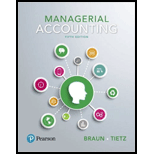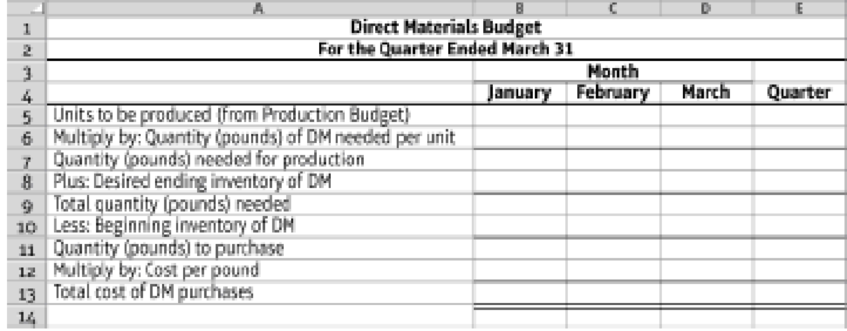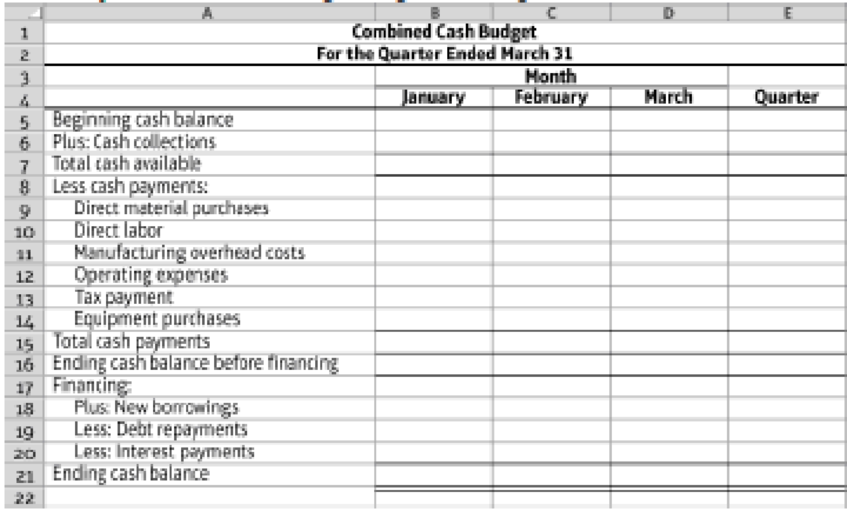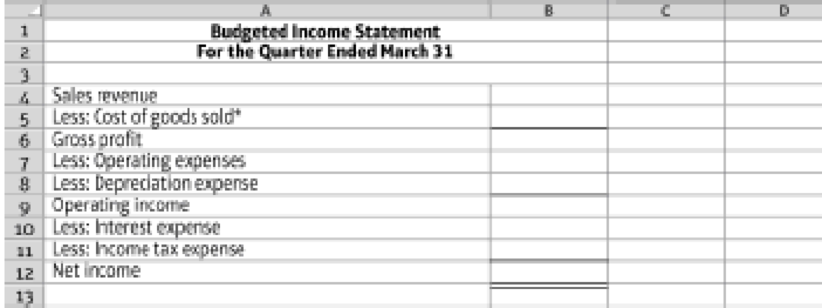
Concept explainers
Comprehensive budgeting problem (Learning Objectives 2 & 3)
Martin Manufacturing is preparing its
| Current Assets as of December 31 (prior year): | |
| Cash | $ 4.500 |
| $ 47,000 |
| Inventory | $ 15,700 |
| Property, plant, and equipment, net | $120,000 |
| Accounts payable | $ 42,400 |
| Capital stock | $124,000 |
| $23,100 |
- a. Actual sales in December were $70,000. Selling price per unit is projected to remain stable at $10 per unit throughout the budget period. Sales for the first five months of the upcoming year are budgeted to be as follows:
| January | $ 80,000 |
| February | $ 92,000 |
| March | $ 99,000 |
| April | $ 97,000 |
| May | $ 85,000 |
- b. Sales are 30% cash and 70% credit. All credit sales are collected in the month following the sale.
- c. Martin Manufacturing has a policy stating that each month’s ending inventory of finished goods should be 25% of the following month’s sales (in units).
- d. Of each month’s direct materials purchases, 20% are paid for in the month of purchase, while the remainder is paid for in the month following purchase. Two pounds of direct material is needed per unit at $2 per pound. Ending inventory of direct materials should be 10% of next month’s production needs.
- e. Most of the labor at the manufacturing facility is indirect, but there is some direct labor incurred. The direct labor hours per unit is 0.01. The direct labor rate per hour is $12 per hour. All direct labor is paid for in the month in which the work is performed. The direct labor total cost for each of the upcoming three months is as follows:
| January | $996 |
| February | $1,125 |
| March | $1,182 |
- f. Monthly manufacturing
overhead costs are $5,000 for factory rent, $3,000 for other fixed manufacturing expenses, and $1.20 per unit for variable manufacturing overhead. Nodepreciation is included in these figures. All expenses are paid in the month in which they are incurred. - g. Computer equipment for the administrative offices will be purchased in the upcoming quarter. In January, Martin Manufacturing will purchase equipment for $5,000 (cash), while February’s cash expenditures will be $12,000 and March’s cash expenditures will be $16,000.
- h. Operating expenses are budgeted to be $1.00 per unit sold plus fixed operating expenses of $1,000 per month. All operating expenses are paid in the month in which they are incurred. No depreciation is included in these figures.
- i. Depreciation on the building and equipment for the general and administrative offices is budgeted to be $4,600 for the entire quarter, which includes depreciation on new acquisitions.
- j. Martin Manufacturing has a policy that the ending cash balance in each month must be at least $4,000. It has a line of credit with a local bank. The company can borrow in increments of $1,000 at the beginning of each month, up to a total outstanding loan balance of $150,000. The interest rate on these loans is 1% per month simple interest (not compounded). The company would pay down on the line of credit balance in increments of $1,000 if it has excess funds at the end of the quarter. The company would also pay the accumulated interest at the end of the quarter on the funds borrowed during the quarter.
- k. The company’s income tax rate is projected to be 30% of operating income less interest expense. The company pays $10,000 cash at the end of February in estimated taxes.
Requirements
- 1. Prepare a schedule of cash collections for January, February, and March, and for the quarter in total. Use the following format:

9.4-49 Full Alternative Text
- 2. Prepare a production budget, using the following format:

9.4-50 Full Alternative Text
*Hint: Unit sales = Sales in dollars/Selling price per unit
- 3. Prepare a direct materials budget, using the following format:

9.4-51 Full Alternative Text
- 4. Prepare a cash payments budget for the direct material purchases from Requirement 3, using the following format. (Use the accounts payable balance at December 31 of prior year for the prior month payment in January.)

9.4-52 Full Alternative Text
- 5. Prepare a cash payments budget for direct labor, using the following format:

9.4-53 Full Alternative Text
- 6. Prepare a cash payments budget for manufacturing overhead costs, using the following format:

9.4-54 Full Alternative Text
- 7. Prepare a cash payments budget for operating expenses, using the following format:

9.4-55 Full Alternative Text
- 8. Prepare a combined
cash budget , using the following format:

9.4-56 Full Alternative Text
- 9. Calculate the budgeted
manufacturing cost per unit, using the following format (assume that fixed manufacturing overhead is budgeted to be $0.80 per unit for the year):

9.4-57 Full Alternative Text
- 10. Prepare a
budgeted income statement for the quarter ending March 31, using the following format:

9.4-58 Full Alternative Text
*Hint: Cost of goods sold = Budgeted cost of manufacturing one unit × Number of units sold
Want to see the full answer?
Check out a sample textbook solution
Chapter 9 Solutions
Managerial Accounting, Student Value Edition Plus MyLab Accounting with Pearson eText -- Access Card Package (5th Edition)
- Opereting income? Accounting questionarrow_forwardWhat is the expected return on the stock on these financial accounting question please give me true answerarrow_forwardDoverly Co. has total assets of $9,200,000 and a total asset turnover of 2.10 times. Assume the return on assets is 10.5%. What is the profit margin?arrow_forward
- Need help this question solution general accountingarrow_forwardDepartment A had 4,700 units in work in process that were 75% completed as to labor and overhead at the beginning of the period, 32,600 units of direct materials were added during the period, 35,100 units were completed during the period, and 2,200 units were 26% completed as to labor and overhead at the end of the period. All materials are added at the beginning of the process. The first-in, first-out method is used to cost inventories.The number of equivalent units of production for material costs for the period was a. 35,100 b. 37,300 c. 30,400 d. 32,600arrow_forwardWhat is the gross profit margin?arrow_forward
- Principles of Accounting Volume 2AccountingISBN:9781947172609Author:OpenStaxPublisher:OpenStax College
